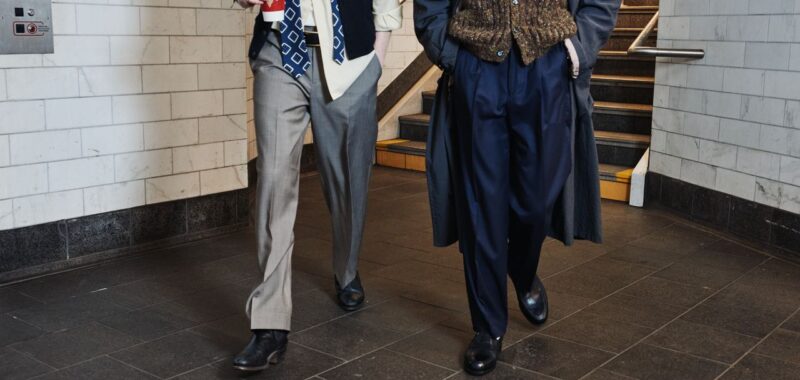From the quality to the art direction, Drake’s has been the go-to label for menswear bros for years. With details like Italian merino wool twill, an after-dinner split, curtained waist, and French bearer button, it’s chock full of tasty little details that make tailoring nerds’ ears perk up.
Best Dress Pants for Fashion Guys: Saint Laurent 90’s Pants
Materials: 100% cashmere | Fit: Wide, wide leg | Pleats: Single pleat | Hem: finished cuff
Sometimes, dress pants can be ultra-flashy—the kind of pants you wear to cut a rug at your local discotech or to strut your stuff down the red carpet (a common occurrence for so many of us, clearly). So if you’re looking for some swanky trousers to paint the town red or color your friends green with envy, Saint Laurent’s 90’s pants will fit the bill. They fit ultra high on the waist with sharp pleats, a relaxed top block and arrow-straight legs leading to a cuff. What you get is a pair of glossy, swaggering trousers that’ll have you feeling like David Bowie. All that’s left is to pair it with your glitziest shoes and your sexiest button-up.
More Dress Pants We Love
What to Look for in a Great Pair of Dress Pants
Ask any menswear nerd and they’ll agree that there’s an art to a well-made pair of dress pants. Of course, the main tenets come down to materials, construction, and fit. But dissecting the minute details can be a chore, especially if you don’t know what you’re looking for.
For materials, seasonality is crucial to consider. Wool gabardines will be great options for three-season wear while cotton twills and linens are suited more for spring and summer. Going into winter, look for heavier fabrics like Donegal, flannel, and tweed. Respected and storied fabric mills are always an easy jumping off point. Some of these include Loro Piana, Vitale Barberis Canonico, and Harris Tweed.
Derek Guy, fashion writer and founder of Die, Workwear!, says to try and opt for the heaviest weight you can comfortable wear, regardless of the season. “Around 12–14 oz. is a good starting place. Lighter fabrics tend to lose their shape and don’t drape as cleanly, which can make the trousers look flimsy.”
The web of microscopic details is easy to get caught up in, but Guy says there’s an easy way to check for quality. “But the real giveaway? Inlay—or more often, the lack of it.” The inlay is the extra fabric located at the seat and side seams of the pant and allows for easy alterations. “When companies are working with tight margins,” he says, “inlay is one of the first things they cut. High-end makers, on the other hand, leave generous inlay as a sign of quality—and as a practical gesture for alterations down the line.”
The built-in leeway to alter a pair of dress pants is important in dialing in a proper fit. Of course, taking advantage of the inlay can only get you so far, but Guy says when you’re looking for the right fit, it’s not so complicated. “Fit refers to a narrow set of technical criteria, and the guiding principle is simple: the trousers should hang cleanly.” It helps to check yourself out in a three-way mirror, if possible. Guy says to look for any areas where the clean lines of the drape are disrupted—flaring at the pockets, ripples at the legs, or fabric catching at the calves. Flared pockets usually means there’s not enough room through the hips or across the lap. If the back rise is too long, that can cause ripples at the back of the legs. And if the fabric is catching at the back of the legs, that’s a sign that the pants are too slim.

